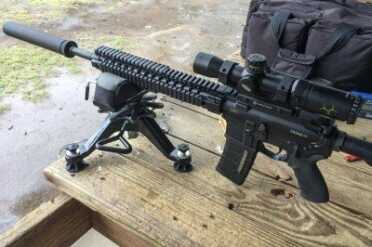
You have to admit, a silencer makes any rifle cooler – like this SilencerCo Specwar 762 on a Daniel Defense DDM4v5 300 Blackout.
Last time we got into an ammunition geek-fest and talked about the variety of commercial ammo available for the 300 AAC Blackout and the endless tinkering you can do as a reloader for that caliber.
Perhaps even more fun than creating endless varieties of ammunition for the 300 AAC Blackout is shooting it with silencers. With subsonic cartridges, usually those firing 208 grain or heavier projectiles at velocities of 1,000 fps or so, you’ll have some serious quiet. Even when using supersonic 300 AAC Blackout ammunition, you’ll notice a dramatically improved shooting experience. Supersonic rounds will still make that little sonic boom, or crack from the bullet traveling through the air, but the gun shot will sound more like a “whoosh” than a “bang.” Hard to describe in words, it’s a little bit like air brakes on a truck. Know what I mean? Trust me, it’s cool.
Before we get started, let me clear up some terminology. Silencer is the correct legal term, and the one coined by Hiram Percy Maxim back in 1902 when he invented the Maxim Silencer. For a long time, the industry used the term “suppressor,” as it was more descriptive. A silencer doesn’t completely silence after all. Recently, industry folks are moving back to the term “silencer” but you’ll see both terms used interchangeably, and both are technically correct – just in different ways.
Let’s talk about some things to consider when silencing the 300 AAC Blackout and close with a look at a few good silencer options currently on the market.
Your gun will experience “the change.”
More likely than not, your rifle will have a point of impact shift when you add a silencer. In plain english, this simply means that the bullet will hit in a different spot when the silencer is on as compared to when it’s off. Just to be clear, assuming you have a half decent gun, your groups will be consistent with and without a silencer, they’ll just be in different places on the paper. Usually, this is not a huge deal – an inch or two difference.
For example, after shooting a bunch of groups with my Daniel Defense DDM4v5 300 AAC Blackout rifle, I added a SilencerCo / SWR Specwar 762. Measuring the distance between before and after groups, I noticed that my rifle impacted about 1 inch lower and ¾ inches to the right at 50 yards when using the silencer. Your results will almost certainly vary as the “change” results from different barrel harmonics. Every silencer is different and every rifle and barrel combination is different. In any case, this is nothing to get concerned about. You’re not likely to see any dramatic shifts, just be aware that you’ll need to re-zero your optic.
I actually noticed a slight improvement in accuracy when I added the suppressor. While not dramatic, groups using identical ammo in identical conditions shrunk just a bit. Again, your results may vary. Have a little fun testing before and after point of impact and accuracy effects to see how your rifle responds.
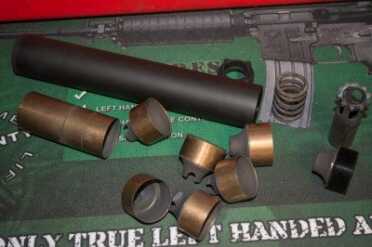
Especially if you’re going to shoot lead projectiles, consider a silencer that comes apart for easy cleaning, like this SilencerCo Octane 45.
Things to consider when choosing a silencer for your Blackout rifle.
Ask yourself these questions before choosing a silencer for your Blackout:
Are you going to shoot only subsonic or a combination of super and subsonic ammunition?
If you’re only going to shoot subsonic ammunition, then you have more options. With the lower pressures of subsonic ammo, you can use a 9mm (or larger) pistol silencer, assuming your silencer manufacturer specifies 300 Blackout compatibility. Usually, pistol suppressors are smaller and lighter, so that’s a benefit. Just be sure to never shoot supersonic ammunition through a pistol silencer not rated accordingly.
Are you going to shoot lead projectiles?
If you want to see how much lead gunk can accumulate over time, try a .22 silencer for a while. It’s somewhat incredible. This is not a big deal if you can clean your silencer once in a while. Some models, especially pistol models like the SilencerCo / SWR Octane come apart so you can thoroughly clean the insides.
Is this a major consideration? Not necessarily, but if you’re one to cast your own bullets and such, you might consider a “cleanable” model. Be sure to check with your manufacturer to see if lead voids the warranty or anything harsh like that.
Are you going to use the silencer “full time” on your rifle or take it on and off?
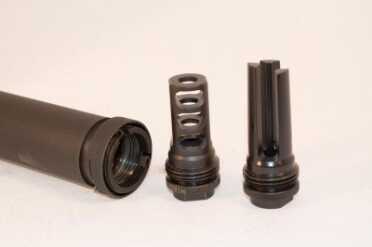
Many silencers, like this SilencerCo Specwar, offer quick attach mounts and compatible muzzle devices, so you can easily move one suppressor to other rifles.
There are two things to consider here.
First, “the change” discussed previously. If your rifle has a significant point of impact shift, then you’ll be faced with the possibility of re-zeroing your scope every time you mount and dismount the silencer.
Second, you’ll want to think about mounting options. Most companies offer quick mount systems where you can buy extra muzzle devices for alternate guns and easily move a silencer back and forth. For example, I use a SilencerCo / SWR Specwar 762 on my Daniel Defense 300 AAC Blackout rifle. The Specwar comes with a muzzle brake inside of the suppressor which mounts to your rifle’s standard barrel threads. The silencer body quick attaches to the muzzle brake or flash suppressor. I bought a second compatible muzzle device for my Rock River Arms LAR-6.8 (a flash suppressor) so I can use the quick mount to easily move the same silencer between rifles. Nearly every manufacturer offers some type of quick mount system, just be sure to order the extra muzzle devices for other guns.
 A few silencer options
A few silencer options
SilencerCo / SWR Specwar 762
This is the model I’ve selected as my primary for my 300 Blackout rifle. It’s designed to handle full power .308, so 300 Blackout supersonic rounds are no problem. It’s 1.5 inches diameter and weighs 24 ounces. Buy some extra muzzle devices and use it on anything smaller also. I’m currently using mine on a Springfield Armory M1A, 6.8 Remington SPC and the .300 Blackout.
SilencerCo / SWR Octane or SilencerCo Osprey
Both the Octane and Osprey are pistol suppressors, but are fine to use with 300 Blackout subsonic. Consider getting one in .45 ACP. It will still suppress 300 Blackout just fine, but buying a larger bore model gives you the flexibility to mount it on .45, .40, 9mm, 380 ACP and even .22LR pistols. The Octane is a traditional tube design, while the Osprey is oblong, with much of the volume situated below the bore line so sights are less obstructed.

Two SilencerCo models that will work with subsonic 300 Blackout: the Osprey (top) and Octane (bottom)
If you buy a pistol silencer for your Blackout, just be sure to use a fixed mount designed for fixed barrel guns. Many pistol suppressors have “boosters” that help maintain reliability in semi-auto pistols where the barrel moves as part of the recoil cycle. That’ll mess you up on a fixed barrel gun like an AR type 300 Blackout.
GemTech GMT-300BLK
Designed for the 300 AAC Blackout, this one will give you 36 – 39dB of sound reduction. Made from titanium, it’s built to last. Perhaps the most important feature is that it’s cleanable, so if you want to lob those big honkin’ 245-grain lead projectiles downrange, you don’t have to worry (as much) about filling up your expensive silencer with lead residue over time.
Advanced Armament Corp (AAC) 7.62-SDN-6
This model is a bit smaller than AAC’s 7.62 SD, which is optimized for the full size 7.62x51mm NATO round with its extra gas volume. You can still fire 7.62x51mm through it however. AAC rates this model at about 126dB when using 300 AAC Blackout subsonic ammunition.
Two for one! The Daniel Defense DDM4ISR
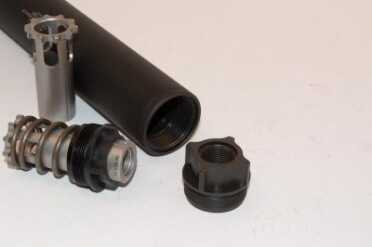
If you choose a pistol silencer, it may have a pistol and spring assembly, or booster, for use on semi-automatic guns where the barrel moves as part of recoil. When using on a fixed barrel rifle, be sure to use a fixed mount.
If you want to just go out and buy the cat’s meow right off the bat, check out the Daniel Defense DDM4ISR. It’s a nifty solution to minimize the bucks you have to pay the feds for a short barrel Blackout and suppressor. Technically, it’s a carbine length gas system rifle with a 10.3 inch barrel, but it features a permanent integrated silencer. This brings the overall “barrel length” to just over 16 inches. Since it’s permanently attached, the rifle is not considered a short barrel rifle (SBR) and subject to a second $200 BATFE tax stamp. You have to buy one stamp for the integrated suppressor, but that’s all. It’s one sweet honey.
One last thing. While too big a topic to go into here in depth, if you haven’t yet bought a rifle, do a little research on pistol versus carbine length gas systems. .223 / 5.56mm rifles can benefit from “longer” gas system (like the mid-length) as recoil is smoothed out a bit. Shorter length gas systems (pistol and carbine) are more violent on the action because faster gas enters the operating system since the port is closer to that big bang. With 300 Blackout using subsonic ammunition, there’s less gas available to start, and it’s moving at slower speed. As a result, pistol length gas systems can be more reliable. Carbine length gas system guns will work just fine, just be aware they might be more sensitive to ammo types when shooting subsonic. So before you buy, think about your anticipated usage of supersonic versus subsonic and do a little homework. Your silencer manufacturer is a great place to start and they should be able to tell you what type of gun will run best with the model of silencer you have.

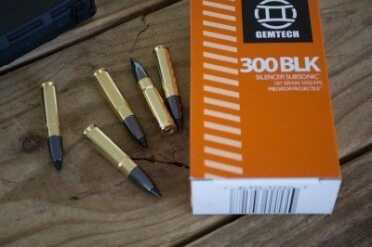
I have the Daniel Defense with a silencerco hybrid. I love the set up but only shooting one round without full reload. Thinking buffer spring or the gas tube. Any recommendations would be greatly appreciated
Indiana just changed hunting regs to allow certain rifle cals for the next 5 hunting seasons. I bought a SW MP15 5.56. I also purchased an extra upper in .300 to deer hunt with. I have extensive experience in Shotgun/Bow hunting but don’t speak the AR language at all. The supersonic/subsonic is confusing. Also wanting to hunt up to 250 yards which grain bullet is best? Any info on this would be appreciated.
Thanks,
Mike H
I am in the market for a licenser/suppressor for my 300BLK. I want to use the gun for deer hunting with a max range of 100-125yds and target shooting as far out as the gun will allow. I would love to do this with subsonic rounds as my hearing disability makes it painful to shoot otherwise. I can use hearing protection while on the range but not as much while in the woods.
Does anyone have any thoughts/suggestions?
Hi Chris. You should consider the amount of sound reduction you are looking for. The suppressor on my 5.56X45 (supersonic) tames the sound to the level of an unsuppressed .22lr pistol or so. If you want quieter than that, the 300blk seems like a good choice. Be aware, many states do not allow the legal use of suppressors for hunting…
(Or maybe I’m just jealous of guys who can regularly go out shooting silenced AR-15s!)
No, I’m with you on this.
Although silencers are cool, just ask James Bond.
OK, if you remember that subsonic 300 ACC Blackout ammo has the same muzzle energy as .45 ACP, it surely has some roles it can fulfill, but unless extreme quiet is important, it’s not for combat or hunting. And even then, well, you can put a scope and a silencer on a Marlin Camp Carbine in .45, and it should be about as effective at ranges under 100 yards — maybe more so since the .45 starts out wider. (The 300 is more aerodynamic and retains more energy at a distance, so if you know the exact range, you can shoot a bit farther, but not with much oomph.)
1. 300 BLK subsonic has more muzzle energy (498 ft·lbf, 220gr sub) than .45 ACP (352-483 ft·lbf, 230gr ball). http://en.wikipedia.org/wiki/300_AAC_Blackout_(7.62%C3%9735mm). http://en.wikipedia.org/wiki/45ACP.
2. 300 BLK was developed for combat at the behest of DoD. http://300aacblackout.com/resources/300-BLK.pdf
3. 300 BLK has a max effective range of 440-460 meters. http://300aacblackout.com/resources/300-BLK.pdf
1. That’s comparing the 300 Blackout in a 16-inch barrel with the .45 ACP in a 5-inch barrel. (And ignoring other .45 ACP options, such as lighter bullets and +P.)
2. Indeed.
3. Yes, but not the subsonic rounds. Of course I would concede that 300 Blackout is more versatile than .45 ACP, because it does have faster rounds. But they are not really suppressible. And OTOH, .45 ACP is more versatile because you can load it into a practical semiautomatic handgun.
1. Same could be said of ignoring the variety of supersonic/subsonic cartridge options, bullet weights, barrel lengths, etc. for 300 BLK.
3(a). Subsonic 300 BLK effective range is 455 meters per Rob Silvers. http://www.300blktalk.com/forum/viewtopic.php?f=128&t=71271
3(b). Supersonic rounds can be suppressed (albeit with less impressive noise reduction) so not sure what you’re getting at there.
3(c). “Versatile” is subjective depending on intended use. It is of little use to make a blanket statement like “X caliber is more versatile” without qualifying it. Same for “practical”.
Note, I’m not disagreeing with you with regard to the utility of the 45ACP round in either a pistol or carbine. I own both. I’m merely addressing what seem to have become common misperceptions (e.g., “it’s not a combat round”) regarding 300BLK.
One of the things I like about it, and one has to determine whether they care about this, is that you have “two” guns. Carry a supersonic and subsonic magazine and you have pros / cons of either simply by loading a new mag on the fly.
Of course the 220 grain MK’s are smaller in diameter than a .45 ACP, but then again, they’re really unstable and tend to upset when they hit things. It’s a heck of a hog hunting round with a suppressor.
Nice article Tom. Very informative. Subsonic Blackout is something every shooter should try. You have to jump through a little red tape to get your hands on the suppressor but it’s worth it. We have so much fun shooting Subsonic 300 Blackout. And even if you are shooting the supersonic stuff, the suppressor definitely helps. Thanks for getting this info out there. You just forgot one thing: the place to get the most badass subsonic blackout ammo is Gorilla Ammunition.
Great Article.
-Mike from Gorilla
I shot some of your 208 grain A-MAX stuff in prep for this article:
http://www.gunsamerica.com/blog/300-aac-blackout-fundementals-ammunition-reloading/
And am doing more for the 300 BLK optics piece coming next week. Very nice load and functioned perfectly in a carbine length gas system rifle, which can be finicky!